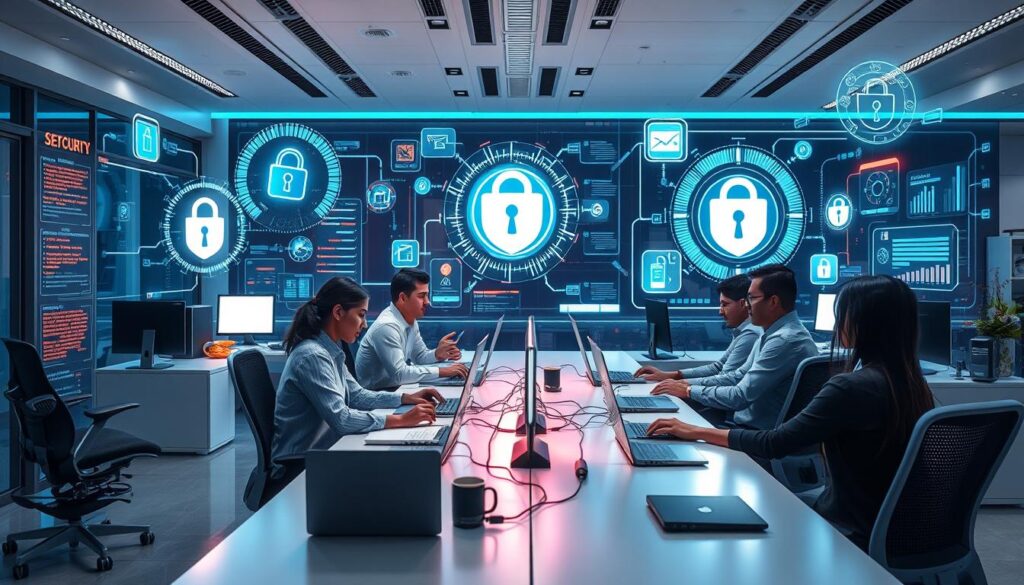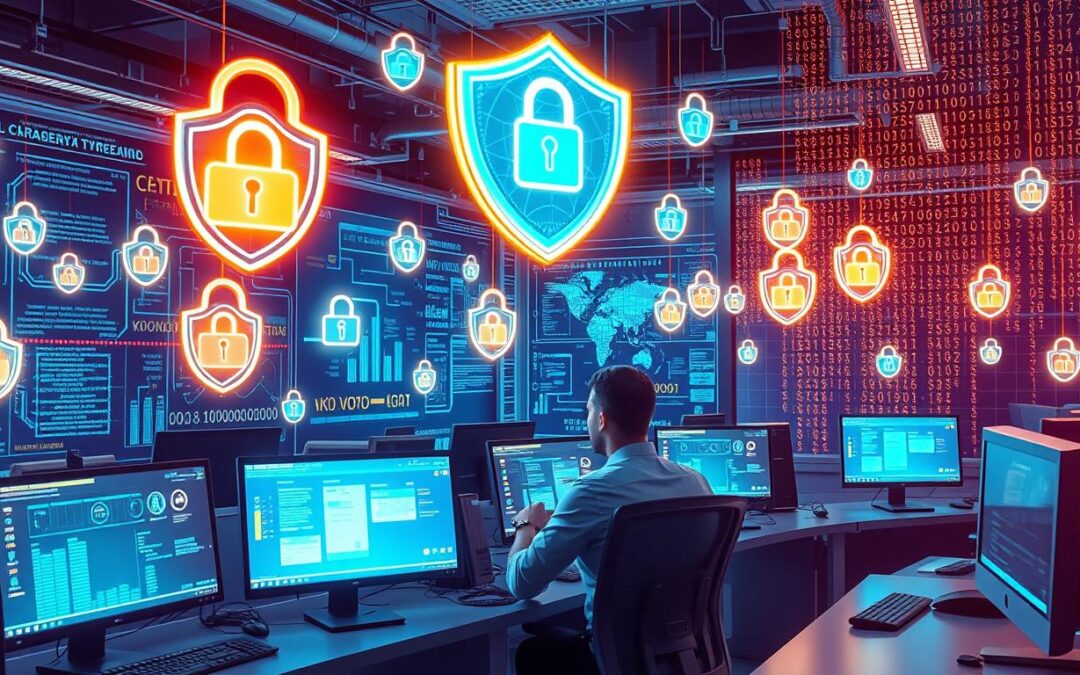In today’s digital world, small and medium enterprises (SMEs) face a big challenge. They must navigate the complex world of cybersecurity compliance. Data protection rules keep changing, and cyber threats get more advanced. SMEs need to protect their important data and assets.
This article will explore the main cybersecurity challenges for SMEs. It will give readers the tools and strategies to boost their cybersecurity. This way, they can meet regulatory requirements.
Key Takeaways
- Understand the importance of data protection regulations and their impact on SMEs
- Identify emerging cyber threats and develop effective risk management strategies
- Implement cybersecurity best practices, including robust information security policies and regular risk assessments
- Leverage compliance frameworks and standards to guide your cybersecurity efforts
- Prioritize network security, employee training, and incident response planning to mitigate cyber risks
Navigating the Complex Cybersecurity Landscape
Small and medium enterprises (SMEs) face a big challenge in the digital world. They must protect their businesses from cyber threats. This means understanding data protection regulations and staying alert to emerging cyber threats.
Understanding Data Protection Regulations
SMEs need to know about the General Data Protection Regulation (GDPR) and other compliance frameworks. Not following these rules can lead to big fines and harm to their reputation. It’s important for SMEs to do risk assessment and create strong cybersecurity policies to prevent data breaches and stay compliant.
Identifying Emerging Cyber Threats
The cyber threat landscape keeps changing, with SMEs facing many dangers. These include ransomware, phishing attacks, and data breaches. It’s key for SMEs to keep up with new cyber threats and use good cybersecurity measures to protect their data and keep their business running.
“In today’s digital age, cybersecurity is no longer an option, but a necessity for SMEs. Proactive measures and a deep understanding of the regulations and threats are essential for protecting your business.”
Risk Management Strategies for SMEs
For small and medium enterprises (SMEs), dealing with cybersecurity can be tough. But, it’s key to protect your business from cyber threats. You can do this by checking your cybersecurity risks, making strong information security policies, and training your employees. This makes your business more resilient.
First, you need to do a cybersecurity risk assessment. This means finding out what’s valuable to your business, seeing what threats could happen, and deciding which ones to tackle first. This helps you use your limited cybersecurity budget wisely.
Creating solid information security policies is also vital. These policies should tell your team how to keep data safe, protect networks, and handle security issues. Keeping these policies up to date helps your business stay safe from new cyber threats.
- Use access controls and multi-factor authentication to keep sensitive info safe.
- Keep your software and systems updated to avoid known problems.
- Have a good backup and recovery plan to keep your business running if you’re hit by a breach.
Teaching your employees about cybersecurity is also key. By teaching them about cyber threats and how to avoid them, you make them your first defense. Regular training and fake phishing tests help create a culture that values cybersecurity.
| Risk Management Strategies | Key Benefits |
|---|---|
| Cybersecurity Risk Assessment | Identify and prioritize risks, optimize cybersecurity budget |
| Comprehensive Information Security Policies | Establish security guidelines, mitigate emerging threats |
| Security Awareness Training | Empower employees, foster a cyber-secure culture |
By using these strategies, SMEs can improve their cybersecurity and protect their assets, even with small budgets.
“Cybersecurity risk management is not a one-time task, but an ongoing process that requires constant vigilance and adaptation to the evolving threat landscape.”
Top Cybersecurity Compliance Challenges for Small and Medium Enterprises (SMEs)
Small and medium enterprises (SMEs) face unique cybersecurity challenges. They often have limited IT resources and budgets. They also lack in-house cybersecurity expertise.
Limited IT Resources and Budgets
SMEs have small IT teams and tight budgets. Compliance audits and security measures are expensive. This makes it hard for them to invest in strong security solutions.
They struggle to keep up with new threats and rules. This is a big challenge for them.
Lack of Cybersecurity Expertise
Many SMEs don’t have cybersecurity experts on staff. This makes it hard to deal with data protection rules and cyber threats. Without the right skills, they find it tough to spot weaknesses and respond to security issues.
To tackle these issues, SMEs can look into affordable cybersecurity options. Cloud-based services and managed security providers can help. They can also partner with cybersecurity experts to get the help they need.
“Investing in cybersecurity is crucial for SMEs, but the challenges of limited resources and expertise can make it a daunting task. With the right strategies and partnerships, however, these businesses can overcome these hurdles and protect themselves from the growing threat of cyber attacks.”
Implementing Cybersecurity Best Practices
Small and medium enterprises (SMEs) face a tough cybersecurity world. They must follow best practices to stay safe and meet rules. This includes making strong information security policies and doing regular risk checks.
Developing Robust Information Security Policies
Making detailed information security policies is key for SMEs. These policies should give clear rules, steps, and who’s in charge of keeping data safe. They help fight cybersecurity risks and follow the law.
Conducting Regular Risk Assessments
Having strong information security policies is just the start. SMEs also need to do regular risk assessments to keep up with cyber threats. These checks find weak spots, see how bad a breach could be, and focus on fixing problems. This way, SMEs can protect themselves better and handle cyber incidents well.
| Key Components of Cybersecurity Best Practices for SMEs |
|---|
|
By following these cybersecurity best practices, SMEs can deal with tough rules, protect their data, and lessen the harm from cyber incidents.

Compliance Frameworks and Standards
For small and medium enterprises (SMEs), navigating cybersecurity compliance can be tough. It’s key to understand and follow popular frameworks and standards. This ensures data protection and meets regulatory needs.
The National Institute of Standards and Technology (NIST) Cybersecurity Framework is well-known. It offers a detailed plan for managing cyber risks. It focuses on network security, cloud security, and mobile device security. SMEs can improve their cybersecurity by using this framework.
The International Organization for Standardization (ISO) 27001 is also important. It outlines how to set up and improve an information security management system (ISMS). This helps protect sensitive data and follow regulations.
For businesses handling payment card transactions, the Payment Card Industry Data Security Standard (PCI DSS) is vital. It sets rules for safe card data processing, storage, and transmission. SMEs in retail and hospitality must follow this standard.
By following these frameworks and standards, SMEs show they care about data protection and risk management. This builds trust with customers and shows they are responsible in the digital world.
Network Security and Access Control
Small and medium-sized enterprises (SMEs) face a tough cybersecurity world. They must focus on strong network security and access control. We’ll look at ways to secure remote access, handle Bring Your Own Device (BYOD) policies, and manage third-party vendor access. This helps prevent security incidents and data breaches.
Securing Remote Access and BYOD Policies
Remote work has increased, making network security key for SMEs. Using strong authentication like two-factor authentication and VPNs is crucial. Also, having strict BYOD policies ensures personal devices meet your security standards.
- Set up strong remote access protocols, including VPNs and multi-factor authentication.
- Create BYOD policies that cover device security, data protection, and acceptable use.
- Keep remote access and BYOD policies up to date to fight new threats.
Managing Third-Party Vendor Access
In today’s world, SMEs often work with third-party vendors. It’s vital to secure these connections to avoid security issues. Create a detailed third-party vendor management program. This should include vetting, access controls, and ongoing monitoring to reduce risks from outside partners.
| Vendor Security Measures | Benefits |
|---|---|
| Vendor risk assessments | Find and fix potential security problems |
| Contractual security requirements | Make sure vendors follow your security rules |
| Continuous monitoring and auditing | Stay ahead of security issues and keep vendors accountable |
By using these network security and access control methods, SMEs can improve their cybersecurity. They can protect their digital assets from threats. It’s important to stay alert and adapt to new dangers to keep your business safe.

Employee Training and Awareness
Teaching employees about security is key for small and medium businesses to boost their cybersecurity. By building a cyber-secure culture, companies can lower the chance of security breaches. This helps protect important data, even when working with outside vendors.
Fostering a Cyber-Secure Culture
Building a cyber-secure culture is more than just setting up security rules. It’s about teaching employees why security awareness training is important. It’s about their part in keeping things safe. Training helps them spot phishing, know how to handle security issues, and stay careful with sensitive info or when dealing with outside vendors.
- Do interactive employee training to boost security knowledge
- Highlight how a cyber-secure culture keeps company data safe
- Make sure employees know their role in security incident response
- Encourage a culture of openness and sharing about cybersecurity tips
By teaching and empowering employees, SMEs can reduce the risk of third-party risk management. This makes their cybersecurity stronger overall.
“Cybersecurity is a shared responsibility, and a cyber-secure culture starts with empowered and informed employees.”
Incident Response Planning and Execution
For small and medium enterprises (SMEs), having a solid incident response plan is key. It helps them deal with security incidents and data breaches quickly. This way, they can lessen the damage from cyber threats.
A good incident response plan has a clear process for handling security incidents. SMEs need to create detailed procedures. These should include how to communicate, how to recover data, and the role of cyber insurance in handling financial and reputation issues after a cyber attack.
Incident Response Essentials
- Set up a clear chain of command and communication channels for a unified response.
- Use strong data backup and recovery plans to get back to normal fast.
- Include cybersecurity risk assessment in the plan to find and fix vulnerabilities.
- Test and update the plan often to keep up with changing security incident response needs.
By planning and practicing their incident response, SMEs can lessen the effects of a security breach. This helps them keep running smoothly and protects their reputation.
| Key Components of an Incident Response Plan | Description |
|---|---|
| Incident Identification and Classification | Set clear rules for spotting and sorting security incidents by their severity and impact. |
| Incident Containment and Eradication | Describe how to stop the incident, lessen its effects, and fix the root cause. |
| Incident Recovery and Restoration | Plan for data backup and recovery to get back to normal and reduce downtime. |
| Post-Incident Review and Lessons Learned | Do a deep analysis of the incident to find ways to improve and update the plan. |
By planning and practicing their incident response, SMEs can lessen the impact of a security breach. This helps them keep running smoothly and protects their reputation.
“Effective incident response planning is not just about reacting to a crisis, but about building resilience and mitigating the long-term consequences of a security breach.”
Third-Party Vendor Management
Small and medium enterprises (SMEs) often use third-party vendors to help with their work. But, this can also bring new cybersecurity risks. It’s important for SMEs to manage these risks well.
Mitigating Supply Chain Risks
One big worry for SMEs is the risk of supply chain vulnerabilities. Cyber threats can get into an organization through its third-party vendor management system. This can harm sensitive data and mess up important business tasks. To deal with these supply chain risks, SMEs need to check and watch their vendors closely.
- Do a deep check on any vendors you might use, looking at their cybersecurity practices and their own supply chain security.
- Make sure you have clear agreements with vendors that cover security, how to handle incidents, and protecting data.
- Keep an eye on how well your vendors are doing and their cloud security to spot and fix any new threats or problems.
| Cybersecurity Considerations | Best Practices |
|---|---|
| Third-Party Vendor Management | Thorough vendor assessment, contractual security requirements, continuous monitoring |
| Supply Chain Risks | Vendor due diligence, incident response planning, supply chain security monitoring |
| Cloud Security | Secure cloud service provider selection, data encryption, access control policies |
| Mobile Device Security | Mobile device management, secure remote access, employee training on BYOD policies |
By tackling third-party vendor management and supply chain risks head-on, SMEs can make their cybersecurity stronger. This helps protect their work from possible problems or data leaks.
Leveraging Cyber Insurance
Cyber insurance is key for small and medium-sized businesses (SMEs) today. It helps protect against data breaches and cyber attacks. It also aids in planning for security incidents and managing risks from third-party vendors.
Cyber attacks can cost SMEs a lot, with the average breach costing $4.35 million worldwide. Cyber insurance can help cover these costs. It pays for investigations, legal fees, and even ransom payments if needed.
Cyber insurance also offers incident response services. These services are crucial after a security breach. They help SMEs contain the breach, notify authorities, and get back to normal. Working with experts can reduce the damage and speed up recovery.
Managing third-party risks is another benefit of cyber insurance. SMEs rely on many suppliers and service providers. Cyber insurance can help cover costs if one of these vendors is breached. This way, SMEs don’t have to bear the financial loss alone.
| Key Benefits of Cyber Insurance for SMEs |
|---|
|
Cyber insurance is a valuable tool for SMEs facing the complex cyber threat landscape. It helps protect assets, ensures business continuity, and strengthens cybersecurity. By using cyber insurance, SMEs can stay safe and resilient.
Conclusion
Small and medium-sized enterprises (SMEs) face many cybersecurity challenges. They must navigate complex rules and implement strong risk management. This is crucial to protect their data and assets.
Using cybersecurity best practices helps SMEs stay safe. This includes creating detailed security policies and doing regular risk checks. Following compliance frameworks also ensures they meet industry rules and avoid legal and financial risks.
Good incident response plans, managing third-party vendors, and considering cyber insurance are key. These steps help SMEs handle cyber attacks better. By taking a comprehensive approach to cybersecurity, SMEs can stay ahead of threats and keep their businesses safe.
FAQ
What are the top cybersecurity compliance challenges for small and medium enterprises (SMEs)?
SMEs face many cybersecurity challenges. These include dealing with complex data protection laws and spotting new cyber threats. They also struggle with limited IT resources and lack the in-house cybersecurity know-how.
How can SMEs effectively manage cybersecurity risks?
SMEs can manage risks by first assessing their cybersecurity threats. They should then create detailed security policies and train employees on security. Even with small budgets, they can find affordable cybersecurity solutions.
What are the key cybersecurity best practices that SMEs should implement?
SMEs should focus on several key practices. These include making strong security policies and doing regular risk checks. They should also follow compliance frameworks and secure their networks and remote work setups. Training employees is also crucial for a cyber-secure culture.
How can SMEs effectively manage third-party vendor risks?
To handle third-party risks, SMEs need to check vendors’ security practices. They should use strict access controls and ensure cloud and mobile device security. Having a solid third-party management policy is also key to avoiding supply chain risks.
Why is incident response planning crucial for SMEs?
Incident response planning is vital for SMEs to lessen the damage from security incidents. They need to have detailed response plans, communication strategies, and data recovery plans. Cyber insurance can also help manage the financial and reputational fallout of a cyber attack.
How can SMEs leverage cyber insurance to enhance their cybersecurity?
Cyber insurance is a key risk management tool for SMEs. It offers financial protection against data breaches and cyber attacks. It also supports incident response and managing third-party risks.

